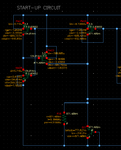AMSA84
Advanced Member level 2

- Joined
- Aug 24, 2010
- Messages
- 577
- Helped
- 8
- Reputation
- 16
- Reaction score
- 8
- Trophy points
- 1,298
- Location
- Iberian Peninsula
- Activity points
- 6,178
Hi guys,
I would like to know which type of circuit one can use to produce a voltage higher than 1.2V but still with the same temperature dependence shape?
Regards.
I would like to know which type of circuit one can use to produce a voltage higher than 1.2V but still with the same temperature dependence shape?
Regards.




